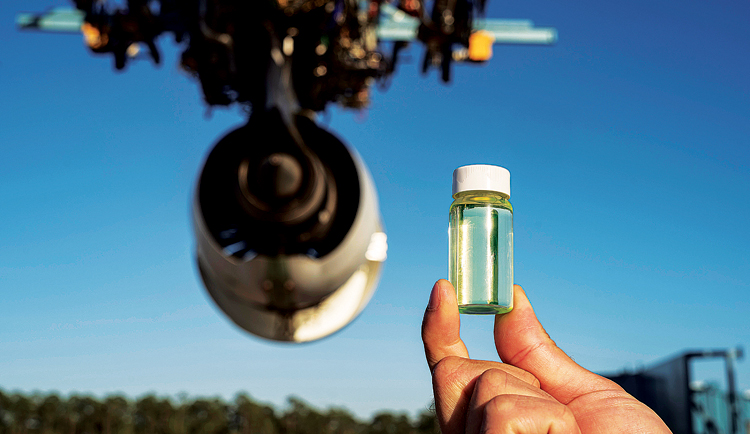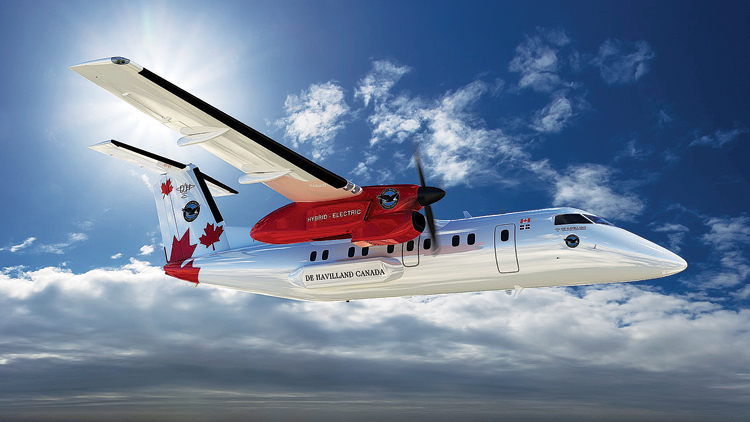Shaping the Future of Sustainable Aviation
Our commitment to powering sustainable aviation is demonstrated by our investments in new technology, materials and products that consume less fuel through increased engine efficiency, including hybrid-electric technology
 | By ASHMITA SETHI, President and Country Head, Pratt & Whitney |
Aviation accounts for 2-3 per cent of the world’s global CO2 emissions, far lower than many other industries. But as electric power generation and surface transportation industries shift to greenand renewable energy sources, aviation’s share of CO2 emissions in total percentage terms could increase, and could impact the climate goals set at the Paris and Glasgow summits, limiting global warming to 2°C . This makes it important for the aviation industry to develop solutions that help airlines further improve their fuel efficiency and reduce CO2 emissions.
So far, it is clear that the solution to sustainable flying doesn’t lie in one ‘silver bullet’, but in pursuing a range of technology solutions, developed for different applications.

We invested more than $10 billion to pioneer the Geared Turbofan. With its unique geared design, the Pratt & Whitney GTF engine allows the latest generation of single-aisle aircraft to be up to 20 per cent more efficient than prior-generation propulsion systems. Since entering service in 2016, GTF engines now power more than 1,000 aircraft and have avoided the emission of more than 5 million tonnes of CO2, while allowing airlines to grow their route networks sustainably.
But we are still only at the beginning of harnessing the potential of this revolutionary technology. We see a clear path to further enhancing the GTF engine’s propulsive efficiency, while also utilising new materials, such as ceramic matrix composites (CMC) parts, to improve thermal efficiency. We recently opened a facility dedicated to the engineering, development and low-rate production CMC materials.
We are looking at further optimising gas turbine efficiency using hybrid-electric technologies, spanning regional turboprops to single-aisle aircraft.

We have progressed our plans to integrate hybrid-electric technology into a Dash 8-100 flight demonstrator, supported by investments from the governments of Canada and Quebec. The regional aircraft-scale demonstrator, developed in partnership with Collins Aerospace and De Havilland Canada, is targeting a 30 per cent improvement in fuel efficiency compared to today’s most advanced turboprops.
Electrification is a rapidly developing field and maturing the technology for smaller applications such as regional turboprops could ultimately inform technology for larger scale turbofan engines such as the GTF.
Improving the efficiency of propulsion systems is at the core of what we do, but it is still only part of the equation to achieving our industry’s decarbonisation goals; the other key ingredient is using cleaner, more sustainable fuels.
Developed from a variety of non-fossil fuel-based feedstocks, Sustainable Aviation Fuels (SAF) have a critical role to play in reducing aviation’s net emissions. They are a “drop in” solution that are already compatible with today’s aircraft and infrastructure and, therefore, offer the best route to decarbonising the tens of thousands of aircraft flying today and in the coming decades.
Pratt & Whitney has been a leader in powering sustainable aviation for decades, and few aircraft engine makers have the depth and breadth of products and experience that we do of over 95 years
We have been closely involved in SAF testing for over a decade, and supported industry regulators in devising the standards that allow SAF to be used today at blends of up to 50 per cent with standard Jet A fuel. We’ve tested 100 per cent SAFs in our PW600 and GTF engines and continue to advance standards for making our engines 100 per cent SAF ready in the future.
As an engine maker, our technical challenge on 100 per cent SAF is relatively modest compared to the more pressing issue of SAF supply and infrastructure. SAF supply accounts for less than 0.1 per cent of fuel used by commercial aircraft today.
It’s long been recognised that SAF production must be urgently scaled up, while the cost per gallon must also be brought more closely in line with kerosene. What’s good for the environment must also be good for business. Fortunately, momentum is building in that direction, with governments in the USA and Europe establishing a range of policies – from tax incentives to investment stimulus – which will help create the best conditions for demand and supply. In India, we are working with the National Bio-ATF Committee – which includes government stakeholders, energy companies, airlines, and academia – to recommend a framework for adoption of SAFs in India.

Besides SAF, we are also looking at alternative, zero-carbon fuels, especially hydrogen. It’s an amazingly energy rich fuel, whose properties we are very familiar with. As early as the 1950s, Pratt & Whitney developed hydrogen-burning engines as part of a top-secret, Lockheed Martin Skunkworks project to build a high-altitude reconnaissance aircraft. “Project Suntan” was intended as a successor to the famous U-2 spy plane but would fly at even higher altitude.
Even back then, we were aware of the challenges of hydrogen, which ultimately led to the project’s cancellation. Hydrogen has three times the energy density of kerosene but takes up four times the volume. To effectively store it, you need to turn it into a liquefied gas at very low temperature of - 253 degree Celsius. As with SAF, another major challenge with hydrogen lies in its supply, both in terms of green production and delivery to airports for fueling.
The challenges are vast, but we will not be deterred from the ultimate goal. Accessible, affordable travel powers the global economy, and connects people. It is part of the fabric of our life and will only continue to grow. It’s clear that our industry, from airlines to manufacturers, is stepping up to the challenge and is determined to make sustainable aviation a reality. We will need a great deal of planning, effort and co-operation among many industry stakeholders, much of which is already underway.
At Pratt & Whitney, we are already planning and preparing for the future, to help airlines and other air operators achieve their goals.





